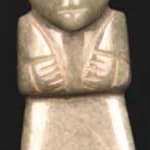Atlantic Watershed Jade Figure-Celt Pendant, 100 CE - 500 CE
Jade
4.5
PF.2455
In the context of Pre-Columbian art and archaeology, jade is a generic term that refers to any variety of hard, dense stones that were worked with great skill by native...
In the context of Pre-Columbian art and archaeology, jade is a generic term that refers to any variety of hard, dense stones that were worked with great skill by native artists. Although jade is generally thought to be green, it can actually be a range of colors. Jade carving flourished in ancient Costa Rica for over a thousand years, roughly from 500 B.C. to 900 A.D., although the period of greatest artistic accomplishment lasted from 300 to 700 A.D. It is believed that jade working began during an extended period of agricultural abundance that allowed the ancient society to dedicate part of its energies toward the cultivation of artistic pursuits.
Jade was considered to be a sacred material by the ancient populations of Costa Rica, held in even higher esteem than gold. Generally, it was thought to symbolize that vital life force that sustains us all. The color green is naturally associated with verdant plant life. Specifically, jade was thought to symbolize the sprouting maize plant, that staple of the Pre-Columbian diet. It has also been suggested that jade represents water. Either way, we can be certain that jade represented the very essence of life itself.
To date, no native sources of jade have been discovered in Costa Rica, suggesting an extended trade network existed that imported this precious resource from Mesoamerica into Costa Rica where it was carved by local artists. Such trade also would have brought great wealth and likely reinforced the social stratification of the peoples. Jade may have served as a status marker to distinguish the elite from the masses and solidify their hold on power. We can picture an ancient ruler or shaman presiding over a sacred ceremonial adorned in brilliant green jade pendants and jewelry. The ancient Costa Ricans believe that the system of social hierarchy also extended into the afterlife. Therefore, jade objects were buried with the elite so that their power could be maintained throughout eternity.
Axe forms are an integral part of virtually every culture known to man. However, Costa Rican axes in the form of figure-celt pendants fashioned from jade are quite distinctive. Jade is a very rare and unique gemstone, found in only half a dozen parts of the world, Mesoamerica being one of these locations. Also, because of its internal structure, jade is one of the toughest and most durable of stones, resulting in the inability of the Pre-Columbian artists to work the stone with the metals that were known and available in Costa Rica at that time. Therefore, the ancient lapidary materials that the artists used to fashion exquisite works of art, such as this jade figure-celt pendant, were nonmetallic: stones of equal hardness, bamboo, twine, sand and water, primarily. Here we see the extraordinary results of an artist's use of these materials, sawing, carving, sanding, drilling, abrading and polishing the raw jade to produce a sophisticated masterpiece--one which is aesthetically appealing to all who experience its spirited beauty. The ultimate in quality and refinement, this jade figure-celt pendant is a testament to the artistic achievements of a culture now lost in time, but certainly not lost in spirit.
Jade was considered to be a sacred material by the ancient populations of Costa Rica, held in even higher esteem than gold. Generally, it was thought to symbolize that vital life force that sustains us all. The color green is naturally associated with verdant plant life. Specifically, jade was thought to symbolize the sprouting maize plant, that staple of the Pre-Columbian diet. It has also been suggested that jade represents water. Either way, we can be certain that jade represented the very essence of life itself.
To date, no native sources of jade have been discovered in Costa Rica, suggesting an extended trade network existed that imported this precious resource from Mesoamerica into Costa Rica where it was carved by local artists. Such trade also would have brought great wealth and likely reinforced the social stratification of the peoples. Jade may have served as a status marker to distinguish the elite from the masses and solidify their hold on power. We can picture an ancient ruler or shaman presiding over a sacred ceremonial adorned in brilliant green jade pendants and jewelry. The ancient Costa Ricans believe that the system of social hierarchy also extended into the afterlife. Therefore, jade objects were buried with the elite so that their power could be maintained throughout eternity.
Axe forms are an integral part of virtually every culture known to man. However, Costa Rican axes in the form of figure-celt pendants fashioned from jade are quite distinctive. Jade is a very rare and unique gemstone, found in only half a dozen parts of the world, Mesoamerica being one of these locations. Also, because of its internal structure, jade is one of the toughest and most durable of stones, resulting in the inability of the Pre-Columbian artists to work the stone with the metals that were known and available in Costa Rica at that time. Therefore, the ancient lapidary materials that the artists used to fashion exquisite works of art, such as this jade figure-celt pendant, were nonmetallic: stones of equal hardness, bamboo, twine, sand and water, primarily. Here we see the extraordinary results of an artist's use of these materials, sawing, carving, sanding, drilling, abrading and polishing the raw jade to produce a sophisticated masterpiece--one which is aesthetically appealing to all who experience its spirited beauty. The ultimate in quality and refinement, this jade figure-celt pendant is a testament to the artistic achievements of a culture now lost in time, but certainly not lost in spirit.
Literature
V8



